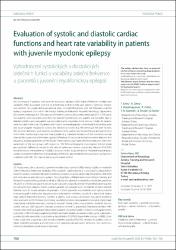| dc.contributor.author | Genç, F. | |
| dc.contributor.author | Genç, A. | |
| dc.contributor.author | Küçükseymen, E. | |
| dc.contributor.author | Erdal, A. | |
| dc.contributor.author | Gömceli, Y. B. | |
| dc.contributor.author | Arslan, S. | |
| dc.contributor.author | Kutlu, Gülnihal | |
| dc.date.accessioned | 2020-11-20T14:50:40Z | |
| dc.date.available | 2020-11-20T14:50:40Z | |
| dc.date.issued | 2018 | |
| dc.identifier.issn | 1210-7859 | |
| dc.identifier.issn | 1802-4041 | |
| dc.identifier.uri | https://doi.org/10.14735/amcsnn2018700 | |
| dc.identifier.uri | https://hdl.handle.net/20.500.12809/1593 | |
| dc.description | WOS: 000452714700010 | en_US |
| dc.description.abstract | Aim: To explore if patients with juvenile myoclonic epilepsy (JME) have differences in heart rate variability (HRV) associated with risk of arrhythmias and in systolic and diastolic functions. Patients and methods: This single-centre prospective study included 50 patients with JME followed up at the epilepsy outpatient clinic within the Antalya Training and Research Hospital's Neurology Department (34 women, mean age 26 +/- 7.58 years) and 45 healthy controls (30 women, mean age 26.71 +/- 5.14 years). Two patients were excluded since they had arterial hypertension, one patient was excluded due to diabetes mellitus and one patient was excluded due to rheumatic mitral stenosis. Finally, 46 patients were included in the study. All patients and controls were evaluated by conventional echocardiography and tissue Doppler imaging for systolic and diastolic functions (e.g. left ventricular ejection fraction, left ventricle diameters and volumes, deceleration time, pulmonary forward flows) and performing 24-h Holter monitoring to explore time domain (e.g. standard deviation of the normal-to-normal interval, the square root of the mean squared differences of successive normal-to-normal intervals) and frequency domain parameters of HRV. Results: There were no significant differences between the Holter parameters of the two groups with respect to HRV. Echocardiographic investigation did not reveal any significant differences except for the ratio of pulmonary venous systolic and diastolic (PVS/PVD) forward flows to one another (p = 0.008). Conclusion: In this study, we did not find anything else about cardiac involvement other than increased ratio of PVS/PVD and we did not find autonomic dysfunction in patients with JME. This may be due to good seizure control. | en_US |
| dc.item-language.iso | eng | en_US |
| dc.publisher | Czech Medical Soc | en_US |
| dc.item-rights | info:eu-repo/semantics/openAccess | en_US |
| dc.subject | Heart Rate Variability | en_US |
| dc.subject | Juvenile Myoclonic Epilepsy | en_US |
| dc.subject | Cardiac Functions | en_US |
| dc.subject | Echocardiography | en_US |
| dc.title | Evaluation of systolic and diastolic cardiac functions and heart rate variability in patients with juvenile myoclonic epilepsy | en_US |
| dc.item-type | article | en_US |
| dc.contributor.department | MÜ, Tıp Fakültesi, Dahili Tıp Bilimleri Bölümü | en_US |
| dc.contributor.institutionauthor | Kutlu, Gülnihal | |
| dc.identifier.doi | 10.14735/amcsnn2018700 | |
| dc.identifier.volume | 81 | en_US |
| dc.identifier.issue | 6 | en_US |
| dc.identifier.startpage | 699 | en_US |
| dc.identifier.endpage | 705 | en_US |
| dc.relation.journal | Ceska A Slovenska Neurologie A Neurochirurgie | en_US |
| dc.relation.publicationcategory | Makale - Uluslararası Hakemli Dergi - Kurum Öğretim Elemanı | en_US |


















